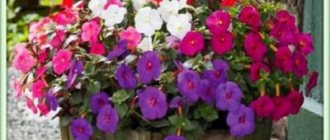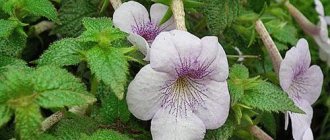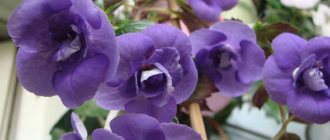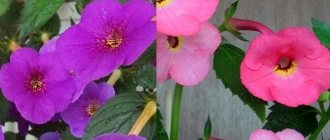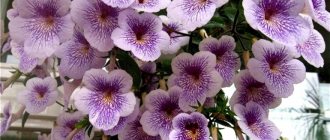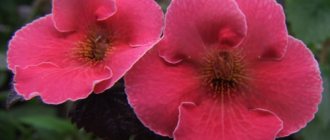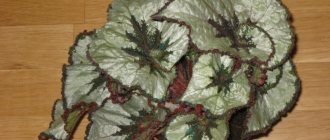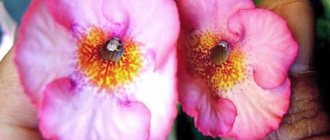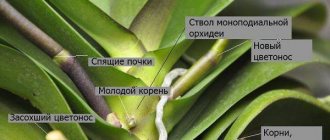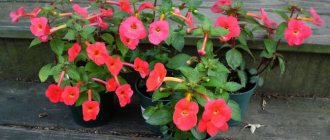Achimenes Yellow English Rose flowers are especially popular among gardeners. Today, breeders have developed a huge number of varieties that differ from each other in the color of not only flowers, but also leaves. Also, the types of Achimenes differ from each other in the type of shoot. Thus they can be erect and ampelous. The advantage of these beautifully flowering plants is that they are relatively easy to care for. With proper flowering, such tropical perennials will delight you with their bright flowers for a long time and abundantly. This article will discuss only a few of them. Below are photos and varieties of Achimenes.
Botanical description
The plant is perennial, the roots are scaly. Flowers are paired or single. All plant species have pubescence. The stems may be branched and the leaves may have serrations, depending on the variety. After opening, the flowers quickly wither, but new buds appear in their place. Different colors: purple, pink, red, yellow and others.
Flowers may have patterns in the form of dots, stripes or specks.
Used in the interior as an hanging plant, in hanging baskets and wall planters.
Achimenes varieties by color
For example, for those who want to grow bushes with yellow flowers, you can pay attention to the following varieties:
- Achimenez Sun Dance. A peculiarity of this species is the presence of an original brown-red speck located in the central part of the bud;
- Jimenez "Giselle" Giselle.
Varieties whose buds are colored lavender and purple include:
- Achimenes Avender Fancy (“Lavender Fancy”);
- Tropical Dusk (“Tropical Dusk”);
- Daisy Boo (“Daisy boo”);
- Peach Blossom;
- Snoweetta;
- Hugues Aufray;
- achimenez lavender fancy;
- Achimenes Venice (“Venice”);
- Achimenes Poseidon “Poseidon”;
- Vivid (“Vivid”);
- peach blossom;
- purple kimono.
Varieties whose inflorescences are colored pink include:
- Achimenes Sabrina;
- achimenez Painted Lady;
- Achimenes Peach Glow (“Peach Glow”);
- Veronika Gotmanova "Veronica".
Varieties whose buds are colored red include:
- Achimenes red Stan`sa Delight (“Stans Delight”);
- Lady in Black
The name of the variety is translated from English as “Difficult to get.” The hybrid has a very variable flower from single to double, with colors ranging from cold cherry to variegated. Bushy, profusely flowering!
information about order
Popular types with photos and descriptions
The number of species exceeds several hundred. Differences in color, shape or size. But there are the most popular types.
Achimenes grandiflora
Achimenes grandiflora grows in Mexico. The height can exceed 50 cm. Large leaf blades, width - 6 centimeters, length - 10 cm. Flowers grow from the axils of the leaves, red-purple in color. 2 flowers grow from one axil. Blooms from early summer to autumn.
Long-flowered
Long-flowered Achimenes (Achimenes longiflora) is a scaly rhizome. The plant is perennial, herbaceous, about 30 centimeters tall. The shoots are green and have pubescence on the surface. The leaves are oblong with pubescence and a serrated edge. The flowers are purple, large, solitary, growing from the axils of the leaves. There are many varieties and forms. Blooms from April to October.
Mexican
Mexican Achimenes (Achimenes mexicana) has ampelous pubescent shoots up to 40 cm in length. The leaves are dark green above and reddish below. The flowers are wide, reddish-purple with a white throat. Blooms from June to October.
Lion's-eye
Achimenes mexicana (Achimenes mexicana) with medium-sized flowers. The leaves are soft and pubescent. The flowering is not abundant, but the flower itself is very beautiful: painted, with different strokes and stripes.
Tiny
Achimenes tiny or misera (Achimenes Misera). Distinctive features are small flowers up to 1 cm in diameter with a purple spot in the center. The leaves are dark green.
Varieties
Achimenes cote d'ivoire
It was obtained as a result of selection by Serge Saliba in 2007. It has rich and varied semi-double flowers with a border. The name of the hybrid speaks for itself. They are medium in size, ivory, soft yellow with light lilac spots on the petals.
Achimenes hard to get
The name translates as “difficult to obtain.” Most likely, they had to work hard on him during selection, since he received such a name. With good fertilizer, rich in phosphorus and potassium, and regular watering, you will get double pink-raspberry or cold cherry flowers with yellow strokes and crimson dots around the throat.
Achimenes glory
A small, hybrid, compact plant, characterized by excellent and long-lasting flowering. Bright large coral-red colors with light centers will definitely delight you with their beauty if you install it on the windowsill in your room.
Achimenes amie saliba
The hybrid appeared 6 years ago, but continues to be popular. It looks like a neat bush. Its flowers are large, sunny, “canary-like”, the edges of the petals are pink. The leaves are light green.
Achimenes strawberry lemon
The name of this miracle translated means “strawberry-lemon” and successfully states its appearance. It looks very beautiful when lemon yellow and soft strawberry colors smoothly flow into each other; over time, the petals can acquire shades of peach and salmon. It depends on the growing conditions.
Achimenes charm
“Charm” refers to hanging plants. The height of its weakly branched erect stems reaches 60 cm. It looks rich with large and bright flowers measuring 4-6 cm in diameter. The corolla is coral-pink with an expressive amber spot, as well as a red-brown speck at the throat. If you provide it with the maximum possible lighting, fresh air and abundant watering, then it will definitely please you, especially in hanging flowerpots.
Achimenes sauline
It is very beautiful, thanks to its small, pale yellow flowers. Along the edges of the slightly wavy petals there is a fuchsia border. The closer to the center, the lilac dots and strokes underlying the golden color become less noticeable. It may fade in bright sun, so it is recommended to keep the flowerpot in partial shade.
Achimenes blueberry lemon
Due to the impressive size of the bush, it requires supports. Its flowers are soft lilac, with a yellow center. The name translates as “Blueberry Lemon”. Depending on the conditions of detention (temperature during flowering, feeding), dominance of one or another tone is possible. An additional petal may form in the throat.
Achimenes pink double
Bush variety. The flower is very delicate, despite its rather large size, up to 5 cm, which is above average. It looks voluminous, terry and can have a range of colors from pale pink to rich pink with a creamy yellow spot in class=”aligncenter” width=”500″ height=”375″[/img]
Achimenes golden lady
Created in 2007, a bush semi-double variety with interesting dark burgundy stems. Gives the impression of a calm color thanks to the light yellow flowers with an admixture of lilac shades at the edges. Medium size and pastel colors. Color may vary depending on temperature. Around the center, where an additional petal sometimes forms, is golden yellow.
Achimenes rainbow warrior
Interesting name, translated means “Warrior of the Rainbow”. It looks very attractive, you want to look at and notice all its nuances. There are specimens with 6 cm buds. Their color varies from lilac to purple. Closer to the middle there are strokes and shadows of cherry, burgundy or dark brown shades. The variety is powerful and tall. You can grow it in an ampoule, but if you are going to use a pot, be sure to choose a stable one.
Achimenes peach glow
Received it as a result of selection of R. Brumpton in 1980. “Peach Blush” has small simple flowers, one might even say small, about 2.5 cm, of a peach hue with a golden throat, the edge of the petals is decorated with carvings.
Care and cultivation at home
Video about caring for and growing Achimenes:
The indoor flower Achimenes is a light-loving plant. But note that the light intensity depends on the type of plant.
If the leaves are dark, a lot of bright light is needed, and direct sunlight cannot harm the flower. If the form is variegated, a bright, diffused room or a slight darkening is perfect. But it is better to avoid direct sunlight, as there is a risk of burns on the leaves.
Air temperature and humidity
During active growth, the recommended temperature is from 20 to 25°. In October, the temperature must be gradually reduced so that the roots gain strength and are ready for the dormant period.
Humidity should be high, but it is forbidden to spray water on the leaves, otherwise rot and mold will appear. To increase humidity, you can spray the air around the flower or pour wet pebbles into a tray. The bottom of the pot should not come into contact with water. If water gets on the leaves, there is a high risk of brown spots.
Watering
Requires abundant watering during the growing period. For this purpose, settled water is used. But stagnation of liquid should be avoided so that rot does not form. In addition, you should avoid getting water on the leaf plates. A syringe is used for watering. The water temperature is slightly above room temperature.
Fertilizers and fertilizers
Feeding begins a month after the appearance of young shoots. Fertilizer should be mineral based. It is applied once every 2 weeks. As soon as the flowering period ends, you can stop feeding.
Rest period
When caring for Achimenes at home, it is very important to correctly treat its dormant period.
In autumn, the leaves of the plant begin to dry out. After trimming, the pot is removed to a cool and dark place, temperature – 15°. Watering should be reduced from the end of September. After pruning, the soil should be moistened once a month with a small amount of water. If you use a lot of water, the plant may begin to grow.
If the flower wakes up ahead of time, move it to a bright place.
At the end of March, a period of active growth begins. Achimenes needs to be regularly watered and fed until next autumn. Place the pot in a warm room with a temperature of about 22°. Having plenty of light is important. After this, active growth and the appearance of buds begins.
Trimming
After the part of the bush dries above the ground, pruning can be done. If you do it earlier, the roots will not have time to receive from the plant the nutrients needed during the dormant period.
Transfer
Typically, the rhizomes of the plant grow at temperatures from 18°. Abundant watering and light play an important role. If you store rhizomes in sand in winter, active growth begins after transplanting into a pot.
Replanting is needed if the indoor plant has grown too large and requires a larger pot. It is also performed if Achimenes has been attacked by insects or diseases. Can be replanted in another soil if more nutrients are needed.
The transplant is performed in early February. The roots are quite short, so a low pot will do. If the root is too large, it can be divided into parts and planted in several pots. You need to cut the roots so that there are growth points on all sections. After the cut area has dried, it is sprinkled with coal in powder form and planted in the substrate. A drainage layer is made at the bottom, filling half the pot. Pieces of brick or expanded clay are suitable for this. The drainage layer is covered with soil. The composition may be as follows:
- leaf soil with sand;
- sand and peat;
- humus, sand and leaf soil.
Any mixture requires the use of a small amount of fine coal. Place the root in the pot, pressing it slightly into the soil. Add the mixture.
Video about pinching achimenes and caring for them at home:
Planting Achimenes rhizomes
To plant rhizomes, it is best to buy ready-made soil, which already contains everything you need, and only after a couple of months, when it is time to transplant the sprouted plant to its permanent place of residence, add the required amount of “feed” closer to the bottom of the pot (away from the root). Then you can add “feeding” once a week when watering, following the recommendations!
It is best to start growing Achimenes at the end of March or beginning of April, when daylight hours increase significantly. Previously planted rhizomes may be elongated and not lush, and late planting (when it is already very warm - in May) can lead to the fact that the plant, which sprouted in abundant warmth, will not be able to adapt and will begin to “go into winter dormancy” earlier than expected, after which , normal adaptation will then take years.
Reproduction
Achimenes can be propagated and grown from seeds.
Seeds are sown in February or March. To do this, use a container filled with large grains of sand. The sowing is covered with film on top and moistened through a tray. Store in a warm place, about 25°, sometimes ventilate. The first seedlings appear in a couple of weeks. As they grow, the pots need to be trimmed. After the bushes have strengthened, they need to be transplanted into a pot. We care for it in the same way as for an adult plant. Seeds can be purchased at a gardening store or collected from an existing plant.
Propagation of Achimenes by cuttings is not a very popular method. The stem is cut and the lower part is taken. It is planted in the sand and covered with a glass jar. The cuttings take root after 2 weeks, and after another 14 days they can be planted in a pot.
A common method of propagating this flower is by rhizomes, which is discussed in a separate article.
Estimates
Leave a review “Hard to Get” Cancel reply
- Tatyana / 06/02/2019: I placed an order last year, now my achimenes have bloomed, but not all of them yet. Very beautiful, I have made a pre-order for other varieties, I hope to receive this one. »
- Svetlana Davydova / 04/19/2019: I received the parcel. Everything arrived perfectly. Thank you for the fast delivery. »
- Galina / 04/07/2019: I received the package, very pleased. Packed so carefully and practically. Thanks a lot. And instructions are included. »
- Tamara Demina / 03/27/2019: [Review moved from the VKontakte group] HELLO, TODAY I RECEIVED A PACKAGE WITH RHIZOMES OF ACHIMENES, I WANT TO SAY A HUGE THANK YOU, THEY WRAPPED THE PACKAGE CONSCIOUSLY, THE RHYZOMES HAVE ALREADY AWAKENED SUCH A CHARM. »
- Nadezhda Babaeva (Bogdanova) / 03/27/2019: [Review moved from VKontakte group] Hello. And here is my first order. I was afraid for a long time, looked closely at the Achimenes, then took a long time to choose. Thanks to the entire team of the World of Achimenes. »
The minimum order amount is 1000 rubles! Delivery regions: throughout Russia, Belarus and Kazakhstan.
Mistakes and care problems
| Problem | Cause what to do |
| The plant was attacked by pests | We use a special insect repellent. |
| Brown spots on leaves | Water for irrigation is too cold. We use a liquid with a temperature slightly above room temperature. |
| Rot formation | Frequent watering and stagnation of water. The soil must dry out |
| Brown buds | The room is too hot, lower the temperature. |
| Plant drying out | Insufficient water and air humidity |
| Lethargy and yellowness | Need to feed more often. |
Watering Achimenes
Achimenes are quite moisture-loving and it is advisable to use drainage when watering. Water for irrigation should be no lower than room temperature (even a little warmer) because if Achimenes feels cool (+15 degrees), it will immediately begin to prepare for winter dormancy, and at +10 the leaves begin to die off and go into “hibernation.”
Do not allow the soil to dry out! It is worth paying attention to the fact that, despite its moisture-loving nature, an adult plant does not like direct wetness. For refreshment, it is recommended to spray water around.
Diseases and pests
Despite the fact that Achimenes is considered a fairly resistant plant, it also gets sick. Most often, this can be ring spotting caused by watering with unsettled or cold water, as well as sunburn.
- With insufficient lighting, iron deficiency may occur, which leads to impaired photosynthesis (chlorosis - yellowing of the interveinal parts of the leaf ).
- An excess of moisture with a violation of the temperature regime (lowering) can lead to the appearance of gray rot, which manifests itself in the form of browning of leaves . In such cases, it is necessary to urgently and carefully free the plant from the affected leaves.
- Achimenes can also be affected by red spider mites . In such cases, you need to spray with special antiseptics and insecticides within the recommended time frame.
